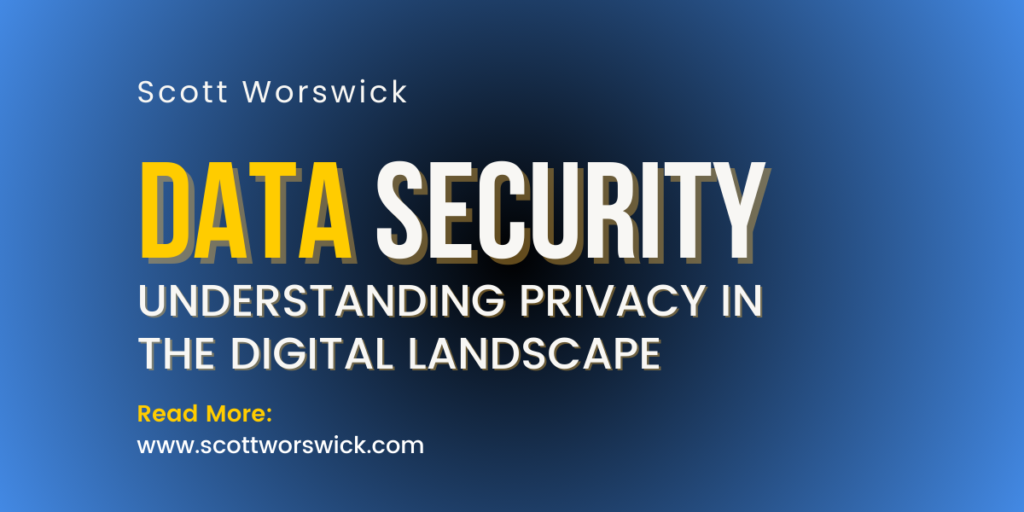In an increasingly digitized world, the debate surrounding privacy and data security has never been more pertinent. As individuals share more and more personal information online, concerns about the protection of this data have skyrocketed. Striking the delicate balance between safeguarding privacy rights and ensuring robust data security measures has become a paramount challenge for organizations and policymakers alike. This delicate dance between privacy and data security is not merely a technical or legal issue; it’s a fundamental aspect of maintaining trust in the digital ecosystem.
Privacy, the cornerstone of individual autonomy, demands meticulous attention in the realm of data protection. With the rapid advancement of technology, personal data has become a valuable commodity, eagerly sought after by corporations for targeted marketing and by cybercriminals for illicit activities. Therefore, crafting comprehensive privacy policies and implementing stringent data protection protocols are imperative to safeguarding individuals’ rights to control their personal information. Balancing this imperative with the necessity of data security measures is essential; after all, what good are privacy rights if data is not securely protected from unauthorized access or exploitation?
However, the pursuit of robust data security measures must not come at the expense of individual privacy rights. Heavy-handed surveillance and data collection practices can erode trust between individuals and the entities that hold their data. Moreover, the indiscriminate collection of personal information can lead to unintended consequences, including discrimination and the chilling effect on free expression. Therefore, finding the equilibrium between privacy and data security requires a nuanced approach that prioritizes both the protection of sensitive information and the preservation of individual autonomy. In essence, achieving the delicate balance in data protection means ensuring that robust security measures coexist harmoniously with respect for individuals’ privacy rights, thereby fostering trust, transparency, and accountability in the digital age.
Table of Contents
1. Privacy vs Data Security – Finding the Balance in Data Protection
In today’s digital landscape, the dichotomy between privacy and data security has become increasingly pronounced, prompting a crucial conversation about finding equilibrium in data protection strategies. Privacy, a fundamental human right, is intricately intertwined with the concept of data security. It encompasses individuals’ rights to control their personal information and dictates how data should be collected, stored, and utilized by organizations. On the other hand, data security encompasses the measures put in place to protect this information from unauthorized access, breaches, or misuse. Striking the delicate balance between these two principles is paramount to fostering trust, promoting innovation, and upholding fundamental rights in the digital age.
At the heart of the privacy versus data security debate lies the tension between individual autonomy and the need for robust protection measures. Privacy advocates argue that stringent data security measures should not infringe upon individuals’ rights to privacy and autonomy. They emphasize the importance of transparency, consent, and user control over personal data, advocating for privacy-enhancing technologies and policies that prioritize user empowerment. However, proponents of data security caution against overlooking the importance of safeguarding sensitive information in the face of evolving cybersecurity threats. They argue that without robust data security measures, individuals’ privacy rights remain vulnerable to exploitation by malicious actors, risking reputational damage, financial loss, and even personal harm.
Navigating this complex terrain requires a multifaceted approach that acknowledges the interconnectedness of privacy and data security. Organizations must adopt a privacy-by-design approach, embedding privacy considerations into every stage of the data lifecycle, from collection to disposal. This entails implementing robust data security measures, such as encryption, access controls, and data anonymization, to protect sensitive information while simultaneously respecting individuals’ privacy preferences. Moreover, regulatory frameworks play a crucial role in setting standards and guidelines for responsible data handling practices, ensuring that organizations adhere to ethical principles and legal requirements in their data processing activities.
Ultimately, finding the balance between privacy and data security in data protection is not a zero-sum game but rather a delicate balancing act that requires ongoing collaboration, innovation, and adaptability. By prioritizing both privacy and data security, organizations can build trust with their stakeholders, mitigate risks, and unlock the full potential of data-driven technologies. In doing so, they contribute to a digital ecosystem where individuals’ rights are respected, and data is treated as a valuable asset worthy of the highest standards of protection.
2. Understanding Privacy in the Digital Landscape

In the dynamic realm of the digital landscape, understanding privacy is paramount for individuals and organizations alike. Privacy transcends mere secrecy; it encapsulates individuals’ rights to autonomy, control, and dignity concerning their personal information. In an era characterized by pervasive data collection and ubiquitous online interactions, safeguarding privacy has become increasingly challenging yet more crucial than ever. It necessitates a comprehensive understanding of the intricate interplay between personal data, digital technologies, and societal norms, highlighting the need for robust data security measures to protect individuals’ privacy rights in the face of evolving threats.
At the core of understanding privacy lies the recognition of individuals’ agency over their personal data. In today’s interconnected world, data has emerged as a valuable currency, driving innovation, powering digital services, and shaping consumer experiences. However, this proliferation of data collection practices raises significant concerns regarding individuals’ privacy rights and the potential for misuse or exploitation. Therefore, fostering a nuanced understanding of privacy entails recognizing the inherent value of personal data and acknowledging individuals’ rights to control how their information is collected, processed, and shared. It underscores the importance of implementing effective data security measures to safeguard sensitive information and uphold individuals’ privacy rights in the digital age.
Moreover, understanding privacy in the digital landscape requires grappling with the complexities of emerging technologies and evolving societal norms. From artificial intelligence and machine learning to biometric recognition and Internet of Things devices, technological advancements have transformed the ways in which personal data is collected, analyzed, and utilized. These developments bring about unprecedented opportunities for innovation and efficiency but also pose new challenges for privacy and data security. As such, fostering a deeper understanding of privacy necessitates ongoing dialogue, collaboration, and education to navigate the intricate intersections between technology, ethics, and privacy rights. By fostering a culture of privacy awareness and promoting responsible data handling practices, stakeholders can work towards finding the delicate balance between privacy and data security in the digital age.
3. The Importance of Data Security Measures
In the intricate dance between privacy and data security, the importance of robust data security measures cannot be overstated. Data security serves as the bedrock upon which individuals’ privacy rights are safeguarded in an increasingly interconnected world. It encompasses a range of technical, organizational, and procedural controls designed to protect sensitive information from unauthorized access, breaches, or misuse. By implementing comprehensive data security measures, organizations not only mitigate the risk of data breaches but also uphold individuals’ trust, confidence, and fundamental rights to privacy.
At the heart of the importance of data security measures lies the recognition of the evolving threat landscape in the digital age. With cyberattacks growing in frequency, sophistication, and impact, organizations face unprecedented challenges in safeguarding sensitive information from malicious actors. From ransomware attacks to phishing scams and insider threats, the stakes have never been higher for ensuring the integrity, confidentiality, and availability of data. Therefore, investing in robust data security measures is not only a matter of compliance with regulatory requirements but also a strategic imperative for protecting organizational assets, preserving brand reputation, and maintaining competitive advantage in the marketplace.
Moreover, the importance of data security measures extends beyond mere risk mitigation; it is intrinsically linked to the broader goals of fostering trust, transparency, and accountability in the digital ecosystem. In an era characterized by heightened concerns about privacy infringements and data breaches, individuals are increasingly scrutinizing how organizations handle their personal information. By prioritizing data security, organizations demonstrate their commitment to respecting individuals’ privacy rights and fulfilling their ethical obligations as custodians of sensitive data. Ultimately, by striking the delicate balance between privacy and data security, organizations can build a resilient foundation for responsible data handling practices, thereby fostering trust and empowering individuals to engage with digital technologies with confidence.
4. The Interplay Between Privacy and Data Security
In the intricate dance between privacy and data security, the interplay between these two concepts is both profound and nuanced. Privacy, often regarded as a fundamental human right, revolves around individuals’ autonomy and control over their personal information. On the other hand, data security encompasses the measures and protocols implemented to safeguard this information from unauthorized access, breaches, or misuse. While distinct in their focus, privacy and data security are deeply interconnected, with each concept reinforcing and complementing the other in the quest for comprehensive data protection strategies.
At the heart of the interplay between privacy and data security lies the recognition of their symbiotic relationship. Robust data security measures form the cornerstone upon which individuals’ privacy rights are safeguarded in the digital age. Encryption, access controls, and data anonymization are just a few examples of the technical safeguards employed to protect sensitive information from cyber threats. By implementing such measures, organizations not only mitigate the risk of data breaches but also uphold individuals’ trust and confidence in their ability to handle personal data responsibly.
Moreover, the interplay between privacy and data security extends beyond mere technical considerations to encompass broader ethical and legal dimensions. Regulatory frameworks such as the GDPR and CCPA set forth guidelines for responsible data handling practices, requiring organizations to prioritize both privacy and data security in their operations. Failure to comply with these regulations can result in severe consequences, including hefty fines, reputational damage, and loss of customer trust. Therefore, achieving the delicate balance between privacy and data security requires a holistic approach that integrates legal compliance, ethical considerations, and technological solutions.
Ultimately, the interplay between privacy and data security underscores the importance of finding equilibrium in data protection strategies. While privacy advocates emphasize the importance of empowering individuals to control their personal information, proponents of data security caution against overlooking the necessity of robust protection measures in the face of evolving cyber threats. By striking a delicate balance between these two imperatives, organizations can foster trust, promote innovation, and uphold fundamental rights in the digital age, thereby creating a more secure and privacy-respecting digital ecosystem for all.
5. Balancing Act: Navigating Regulatory Landscape
Navigating the regulatory landscape surrounding privacy and data security is akin to walking a tightrope, requiring organizations to strike a delicate balance between compliance and innovation. With the proliferation of data protection laws and regulations worldwide, including the GDPR, CCPA, and others, organizations face a complex patchwork of legal requirements aimed at safeguarding individuals’ privacy rights while ensuring robust data security measures. Compliance with these regulations is not only a legal imperative but also a strategic necessity, as non-compliance can lead to hefty fines, reputational damage, and loss of customer trust.
Central to the balancing act of navigating the regulatory landscape is the recognition of the interconnectedness between privacy and data security. Regulatory frameworks such as the GDPR emphasize the importance of implementing technical and organizational measures to ensure the confidentiality, integrity, and availability of personal data. From conducting data protection impact assessments to appointing data protection officers and implementing data breach notification procedures, organizations must prioritize data security as an integral component of their compliance efforts. By integrating data security measures into their regulatory compliance initiatives, organizations can mitigate the risk of data breaches and demonstrate their commitment to protecting individuals’ privacy rights.
However, achieving compliance with data protection regulations is not without its challenges. The regulatory landscape is constantly evolving, with new laws, guidelines, and enforcement actions shaping the data protection landscape. Moreover, the global nature of data flows presents additional complexities, requiring organizations to navigate differing legal requirements across jurisdictions. As such, maintaining compliance requires ongoing vigilance, investment, and adaptability to ensure that data security measures remain robust and effective in mitigating emerging threats.
Ultimately, successfully navigating the regulatory landscape requires a holistic approach that goes beyond mere box-ticking exercises. Organizations must foster a culture of privacy and data security awareness, embed privacy principles into their business practices, and collaborate with regulators and other stakeholders to address emerging challenges proactively. By embracing privacy and data security as core values and integrating them into their operations, organizations can navigate the regulatory landscape with confidence, thereby building trust, enhancing their reputation, and safeguarding individuals’ privacy rights in the digital age.
6. Embracing Ethical Considerations

Embracing ethical considerations is essential in the ongoing discourse surrounding privacy and data security. While technical solutions and regulatory compliance play crucial roles in safeguarding sensitive information, ethical considerations serve as the moral compass guiding organizations’ actions in the digital landscape. At the heart of ethical considerations lies a commitment to upholding individuals’ rights, autonomy, and dignity concerning their personal data. By placing ethics at the forefront of data protection efforts, organizations can navigate the delicate balance between privacy and data security with integrity and transparency.
One of the key ethical considerations in data protection is the principle of informed consent. Individuals have the right to know how their data is being collected, processed, and shared, and to provide consent based on clear and understandable information. Transparent communication and user empowerment are essential in ensuring that individuals are fully aware of the implications of sharing their personal information and can make informed decisions about its use. By prioritizing informed consent, organizations demonstrate respect for individuals’ autonomy and foster trust in their data handling practices, thereby strengthening the foundation of data security.
Moreover, ethical considerations extend beyond mere compliance with legal requirements to encompass broader societal values and norms. Organizations have a responsibility to consider the potential impact of their data processing activities on individuals, communities, and society as a whole. This includes addressing issues such as data discrimination, algorithmic bias, and the equitable distribution of benefits and risks associated with data-driven technologies. By embracing ethical considerations, organizations can proactively mitigate the risks of harm and ensure that their data security measures uphold the principles of fairness, justice, and equity.
Ultimately, embracing ethical considerations in data protection is not just a moral imperative but also a strategic advantage. By aligning their actions with ethical principles, organizations can differentiate themselves in the marketplace, build stronger relationships with customers and stakeholders, and mitigate the risk of reputational damage. Moreover, ethical data handling practices contribute to a more sustainable and resilient digital ecosystem, where privacy rights are respected, and data security is upheld as a fundamental value. By embracing ethical considerations, organizations can navigate the complexities of privacy and data security with integrity and purpose, thereby fostering trust, promoting innovation, and upholding fundamental rights in the digital age.
7. Innovating for a Secure Future
Innovating for a secure future necessitates a proactive approach to addressing the evolving challenges of privacy and data security in the digital age. While privacy concerns and data security threats continue to proliferate, innovation serves as a beacon of hope, offering novel solutions and strategies to navigate the delicate balance between protecting sensitive information and fostering technological advancement. By harnessing the power of innovation, organizations can stay ahead of the curve, adapt to changing landscapes, and build a more secure future for all stakeholders involved.
Central to innovating for a secure future is the development and adoption of cutting-edge technologies and practices that prioritize data security while respecting individuals’ privacy rights. From encryption and tokenization to advanced authentication methods and secure data sharing protocols, innovative solutions abound for protecting sensitive information from unauthorized access, breaches, or misuse. By investing in research and development efforts aimed at enhancing data security, organizations can stay one step ahead of cyber threats and safeguard valuable assets from potential harm.
Moreover, innovating for a secure future requires a holistic approach that integrates technological advancements with ethical considerations, regulatory compliance, and stakeholder engagement. Organizations must foster a culture of privacy and data security awareness, embedding these principles into their business practices and decision-making processes. By embracing a multidisciplinary approach to innovation, organizations can create synergies between privacy, data security, and other core business objectives, driving sustainable growth and resilience in the digital landscape.
Ultimately, innovating for a secure future is not just about developing new technologies; it’s about fostering a mindset of continuous improvement and adaptation in response to emerging threats and opportunities. By embracing innovation as a catalyst for change, organizations can forge a path towards a more secure and privacy-respecting digital ecosystem. From startups to multinational corporations, every entity has a role to play in driving innovation forward and shaping a future where individuals’ privacy rights are upheld, and data security is a fundamental priority.
Conclusion
In conclusion, the discourse surrounding privacy versus data security underscores the intricate dance organizations must perform to find equilibrium in data protection strategies. While privacy and data security are distinct concepts, they are inherently intertwined, each dependent on the other to ensure the responsible handling of sensitive information. Throughout this exploration, it has become evident that striking the delicate balance between privacy and data security is paramount to fostering trust, promoting innovation, and upholding fundamental rights in the digital age.
As we reflect on the importance of this balance, it is clear that robust data security measures serve as the foundation upon which individuals’ privacy rights are safeguarded. Encryption, access controls, and data anonymization are just a few examples of the technical safeguards employed to protect sensitive information from cyber threats. By implementing comprehensive data security measures, organizations not only mitigate the risk of data breaches but also demonstrate their commitment to respecting individuals’ privacy preferences and upholding ethical standards in data handling practices.
Furthermore, navigating the regulatory landscape surrounding privacy and data security requires organizations to adopt a proactive approach that goes beyond mere compliance with legal requirements. Regulatory frameworks such as the GDPR and CCPA set forth guidelines for responsible data handling practices, requiring organizations to prioritize both privacy and data security in their operations. By integrating data security measures into their regulatory compliance initiatives, organizations can mitigate the risk of non-compliance and build trust with stakeholders, thereby enhancing their reputation and competitive advantage in the marketplace.
In essence, finding the delicate balance between privacy and data security is an ongoing journey that requires collaboration, innovation, and adaptability. By embracing ethical considerations, leveraging innovative technologies, and fostering a culture of privacy and data security awareness, organizations can navigate the complexities of the digital landscape with confidence and purpose. Ultimately, by prioritizing both privacy and data security, organizations can create a more secure and privacy-respecting digital ecosystem, where individuals’ rights are respected, and sensitive information is protected from harm.





Pingback: Compliance and Data Security: Navigating Regulatory Requirements -